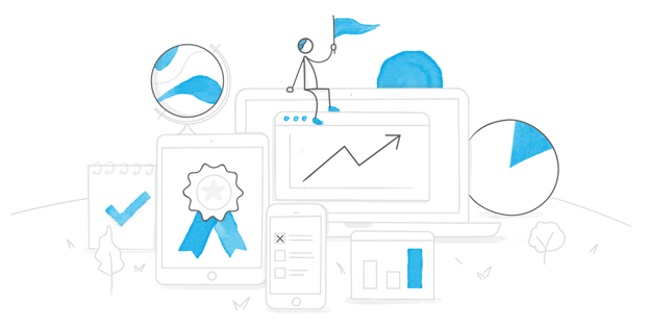While you are reading this, you should be aware that we have entered a new era of learning – the era of online learning. While the concept of online learning may be well familiar to you, and you know what it can do for you individually or for your businesses, there are quite a few people who don’t fully understand one new concept attached to it.
And this is, of course, blended learning – a learning approach that is created by mixing of both online and offline learning experiences in a specific way, so that they complement one another. This type of learning is possible with a Tin Can compliant learning management system (LMS).
In order to better understand how Tin Can LMS supports blended learning, we have compiled a list of Qs & As.

What is Blended Learning?
While traditional online learning happens inside the boundaries set by currently applied technologies, blended learning extends far beyond it. Blended learning respects individual learning preferences by allowing students to learn what they want, instead of serving them with a strict list of knowledge resources.
Blended learning incorporates learning from presented course materials, discussions on emails and forums, guided learning, watching videos, reading numerous articles online or any other learning activity in which a student willingly participates. While leveraging the power of the Internet, blended learning allows students to choose their own pace, place and time of learning.
This all sounds great, but how can one track so many activities for each student or employee individually? This is where Tin Can comes in.

What is Tin Can?
Tin Can API is, simply put, a software specification. It is also known as Experience API or, shortly, xAPI. This software specification records every activity of a student in a Learning Record Store (LRS), and these activities are stored as statements. For instance, “John, watched ‘How to Be More Productive at Work’ video, on YouTube”.
This software is capable of tracking user activities on all types of devices. Smartphones, tablets and computers become a powerful ally in user activity tracking because Tin Can enable them to record the streams of activities that students do.
Any application enabled by Tin Can takes an activity that is classified as learning, captures it and stores it in a Learning Record Store (LRS). While it is a standalone platform, incorporating Tin Can in an LMS is possible.
Since Tin Can API allows storage of data in multiple LRSs and communication between them, opportunities for Tin Can applications are numerous. Let’s see what it does for a Learning Management System.
What is a Tin Can Compliant LMS?
An LMS that works without Tin Can API support is only capable of recording a number of courses taken by the learner, and the learner’s course scores and progression. I did intentionally say “only” because in the modern environment learners use more than just one resource to find information and to learn. This means that an LMS without Tin Can support is not able to track these learning experiences or to store them.
On the other hand, a Tin Can compliant LMS incorporates the best from both worlds. It allows learners and course designers to leverage both traditional online learning methods and the brand-new ones. Thanks to the Tin Can API and its easy integration, a Tin Can LMS is completely capable of not only supporting blended learning but also fostering and promoting it.

What are The Benefits of Tin Can LMS?
Let’s start with the essential benefit – the ability of Tin Can compliant LMS to track a great variety of learning types at once. This allows business and educational organizations, as well as learners, to fully unlock and leverage the power of blended learning.
The tracking can be extended to mobile platforms as well, enabling the course creators to track everything that takes place in the entire learning ecosystem, ranging from mobile and blended learning to simulations and gamification.
Another benefit of Tin Can LMS is its rich reporting data. Instead of having access only to score, and course progression and completion, course creators can now have insight into team scores, multiple scores and attempts of a student from the same course.
The data can be used to make the timeline of learning events that took place. This can be used to identify which lesson or practice made the learners wander off to another resource, and utilized to make the courses and learning experience better and more personalized for each participant.
As we already explained, with Tin Can LMS you can also store learning experiences outside of the LMS, but another benefit of using it is the ability to utilize content outside of the LMS as learning material. Since the trackable content doesn’t necessarily have to be contained within the LMS, the learning effectiveness can easily be assessed via analyzing data stored in the LRS.
One of the main goals of an online course and training creators is to improve the quality of the learning material. With Tin Can LMS, it is very easy to find out how learners interact with the provided learning material. Since the creators can see which types of learning their students prefer, they can devote their time and effort to creating materials that will be able to completely meet the demands and needs of their learners.
In the end, the LMS powered by Tin Can is also capable of tracking learners’ activities on social media networks. Course creators can easily identify the interests and likes of their learners and can utilize this knowledge to further personalize the learning experience for each enrolled individual.
This has a positive impact on the effectiveness of learning, which is very important in periods when quick progression is of the essence for a learner’s or organization’s success.
Summing up
As you can see, Tin Can API can easily be integrated with an LMS and turn it into an even more powerful learning tool. Since Tin Can allow tracking of learning experience across multiple channels, a Tin Can compliant LMS is more than capable of sustaining and supporting blended learning.
Author Bio
Kamy Anderson is an ed-tech enthusiast with a passion for writing on emerging technologies in the areas of corporate training and education. He is an expert in learning management system & elearning authoring tools – currently associated with ProProfs.
Is Tin Can LMS Capable of Supporting Blended Learning?,





brainaudio
Sep 17. 2017
Software applications help people in different ways. It is up to you if you wanted to enjoy learning.
Albert
May 12. 2020
Great article. Thank you!